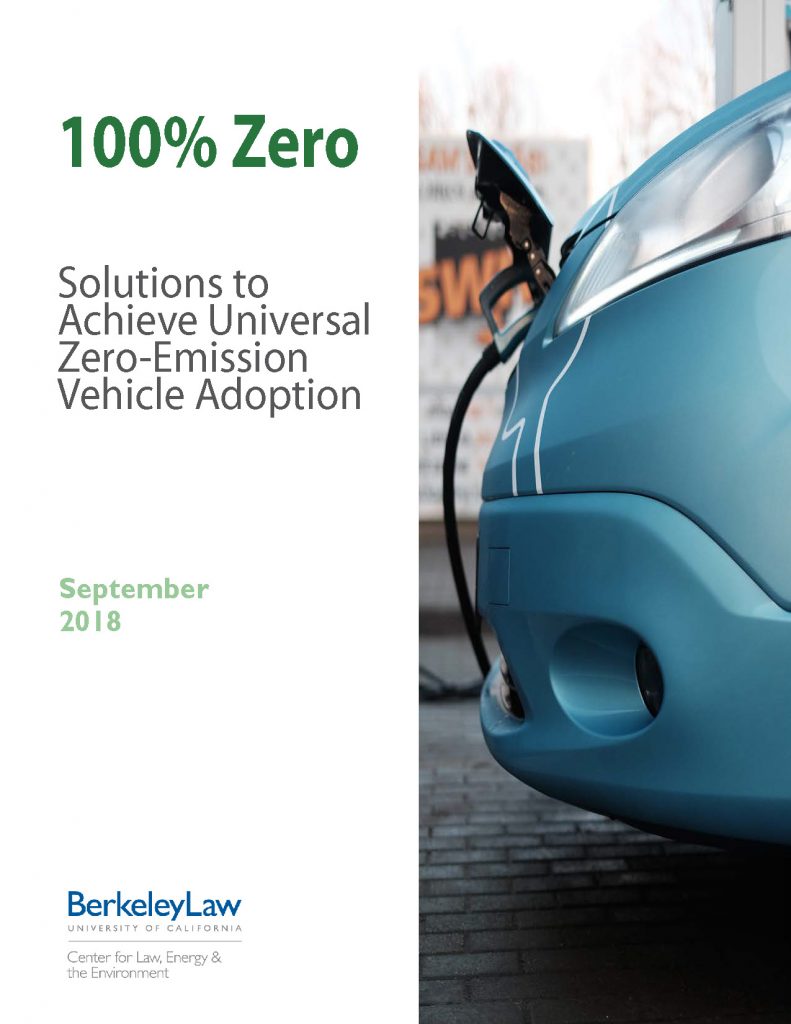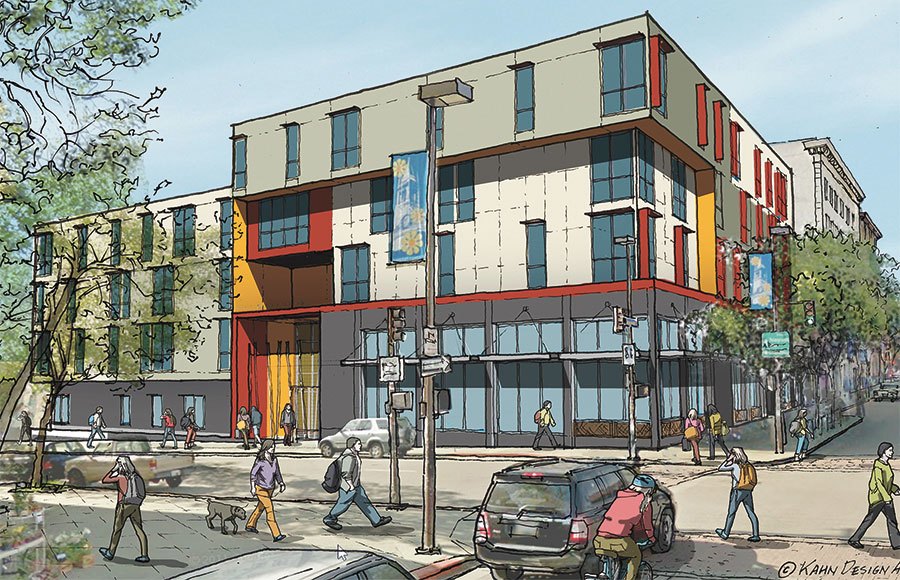
Governor Newsom made a major announcement this week, issuing an executive order that California would ban the sale of new internal combustion engine passenger vehicles by 2035, and medium and heavy-duty vehicles by 2045. I’ll discuss the order and its implications this morning at 9am on KQED radio’s Forum.
We released a report at Berkeley Law’s Center for Law, Energy and the Environment (CLEE) on this very subject in 2018, called 100% Zero. The bottom line: this is a major new announcement that is necessary to tackle climate change and should be economically and technically feasible, assuming the state takes additional implementation steps discussed in the report.
However, whether it’s legally feasible for California to implement this order will almost inevitably revolve around this or future presidential elections, as well as the composition of the United States Supreme Court.
Tune in today for more details!

Housing policy is at the center of all of our major societal problems in the United States:
- Care about racial justice? Restrictive housing and land use policies are responsible for our deeply segregated towns and cities.
- Climate change? Bad housing policies are the reason why so many people are forced into long, emission-spewing commutes, because they can’t afford to live close to their jobs.
- Economic inequality? Inflated home prices and rents increasingly force middle- and low-income residents into low-opportunity areas, while shutting them out of the wealth-generating possibilities of home ownership. Just to name a few issues affected by housing.
So why can’t we address the high cost of housing, particularly near transit and jobs? There are two culprits: high-income homeowners who support exclusionary local land use policies that restrict housing supply, which prevents others from moving into their communities and deprives them of the educational and economic opportunities that come with living in these areas. Second, the state and federal government is unwilling to provide sufficient public subsidies for affordable housing (though the scale of the need at this point is simply massive, especially given the country’s inability to build housing at a reasonable price).
Perhaps with these dynamics in mind, then-Lieutenant Governor Gavin Newsom campaigned for governor in 2018, promising 3.5 million new housing units to address the state’s severe housing shortfall. But after two legislative sessions, the Governor so far has no meaningful legislative accomplishments on increasing housing production. Like 2019, this just-concluded 2020 legislative session proved to be a bust (yes, Covid-19 interfered, but housing was one of the few remaining priorities that the legislature was committed to addressing this year).
Here are the gory details of the housing bills from the original legislative “housing package” in January that did not survive:
Assembly defeats:
- AB 1279 (Bloom): would have identified high-resource areas with strong indicators of exclusionary patterns and require zoning overrides to encourage production of small-scale market-rate housing projects and larger-scale mixed-income affordable projects.
- AB 2323 (Friedman): would have expanded CEQA infill exemptions to projects in low-vehicle miles traveled (VMT) areas.
- AB 3040 (Chiu): would have incentivized cities to upzone to allow for fourplexes in neighborhoods currently zoned solely for single-family housing.
- AB 3107 (Bloom): would have allowed streamlined rezoning of commercial land for housing.
- AB 3279 (Friedman): would have amended administrative and judicial review for various projects under the California Environmental Quality Act (CEQA).
Senate defeats:
- SB 899 (Wiener): would have streamlined review for religious institutions seeking to build housing on their property.
- SB 902 (Wiener): would have streamlined approval for up to 10 housing units per parcel near transit.
- SB 995 (Atkins): would have fast-tracked CEQA review for environmentally beneficial infill projects.
- SB 1085 (Skinner): would have expanded density bonus law by allowing rental housing developers to increase the size of their projects 35% if at least 20% of the units were moderately priced (rent at 30% below market rate for the area).
- SB 1120 (Atkins): would have allowed two homes on every property zoned for single-family homes in California; would have also allowed single-family properties to be split into two lots.
- SB 1385 (Caballero): would have made it easier to rezone commercial land for housing and streamline approval for projects on that land.
- SB 1410 (Caballero): would have provided rental relief through tax credits to landlords to fill unpaid rent.
It’s also worth reiterating that the senate voted down in January an amended version of Senate Bill 50 (Wiener), which would have reduced local restrictions on apartments near major transit and jobs.
And strangely, SB 995, SB 1085, and SB 1120 all passed the Assembly at the last minute, but Assembly Speaker Anthony Rendon scheduled the vote too late for a concurrence vote in the Senate. As a result, the bills died.
But the news was not all bad. Some housing bills did pass, including:
- AB 725 (Wicks): requires that no more than 75 percent of a city’s regionally assigned above-moderate income housing quota can be accommodated by zoning exclusively for single-family homes, with the remainder on sites with at least 4 units.
- AB 1851 (Wicks): requires local governments to approve a faith-based organization’s request to build affordable housing on their lots and allows faith-based organizations to reduce or eliminate parking requirements.
- AB 2345 (Gonzalez): increases the density bonus and the number of incentives available for a qualifying housing project.
- SB 288 (Wiener): temporarily exempts from CEQA review infill projects like bike lanes, transit, bus-only lanes, EV charging, and local actions to reduce parking minimums, among others, until 2023 (disclosure: I helped Assemblymember Laura Friedman and Assembly Natural Resources Committee chief consultant Lawrence Lingbloom draft the parking provision, along with Mott Smith of the Council of Infill Builders).
So there we have it in 2020. A few successes, but mostly a wipeout. Perhaps recognizing the urgency after two failed sessions, Governor Newsom appeared this week to offer something of a belated endorsement of SB 50 and SB 1120, two of the more consequential bills that failed in the legislature this year:
But absent strong leadership from the Governor’s office and legislative leaders, this pattern of failure on housing production will likely continue, exacerbating all the challenges I discussed above that are affected by dysfunctional housing policy. That means we can expect worsening racial injustice and segregation, greenhouse gas emissions, and economic inequality, to name just a few, until the state can finally, meaningfully address this problem.

Governor Newsom’s “State of the State” speech today offered an abrupt scaling back of the state’s vision for its signature infrastructure project, high speed rail from Los Angeles to San Francisco:
[L]et’s level about high speed rail. I have nothing but respect for Governor Brown’s and Governor Schwarzenegger’s ambitious vision. I share it. And there’s no doubt that our state’s economy and quality of life depend on improving transportation. But let’s be real. The project, as currently planned, would cost too much and take too long. There’s been too little oversight and not enough transparency. Right now, there simply isn’t a path to get from Sacramento to San Diego, let alone from San Francisco to L.A. I wish there were. However, we do have the capacity to complete a high-speed rail link between Merced and Bakersfield.
In some ways, his position is a simple nod to fiscal reality. There aren’t enough funds right now to complete the project beyond this initial phase in the Central Valley anyway. Voters approved roughly $10 billion in bond funding in 2008, the 2009 federal “stimulus” bill offered another $3.5 billion, and Governor Brown and the legislature dedicated about 25% of cap-and-trade auction proceeds to continue building the system.
But that’s not enough to connect the Central Valley portion through the Pacheco Pass into San Jose, where it could then connect to the soon-to-be-electrified Caltrain into San Francisco. And it’s nowhere near the multiple billions of dollars needed to tunnel through the Tehachapi Mountains to connect to Southern California.
The key is the federal government: with Republicans in complete control of Congress from 2011 until last month, they were unwilling to match the state’s investment with federal dollars. While highway projects will get 90-100% funding from the federal government and intracity rail transit will get 50%, high speed rail has gotten just about 15% in federal matching funds — and only from that one-time 2009 stimulus grant.
If California had received closer to a 50% match from the federal government, the rail system would have the money to connect to the Bay Area. That link would provide significant economic benefits for Central Valley cities like Fresno and Merced by connecting them to the prosperous coastal economy. And it would create immediate benefits to bolster the long-term political support needed to eventually extend the system to Southern California.
But Governor Newsom’s speech today shows that he’s unlikely to spend much political capital to fight for these federal dollars from a congress that now features many California representatives, including the speaker, in control of the House of Representatives. It’s a position consistent with his 2014 interview in which he stated he would redirect funds from the system to other infrastructure needs.
Instead, his scaled-back vision presents a message that may confirm critics’ charges that the system is flawed and potentially infeasible. Some also worry that the new plan will embolden more litigants, arguing that the change in project vision violates the terms of that original 2008 bond initiative, although the courts have so far been deferential to state leaders on this question.
High speed rail backers will ultimately need a change in federal leadership come 2021 to get the necessary funds to complete the project — but it looks like they will have only tepid support from the state’s new governor in the meantime.


